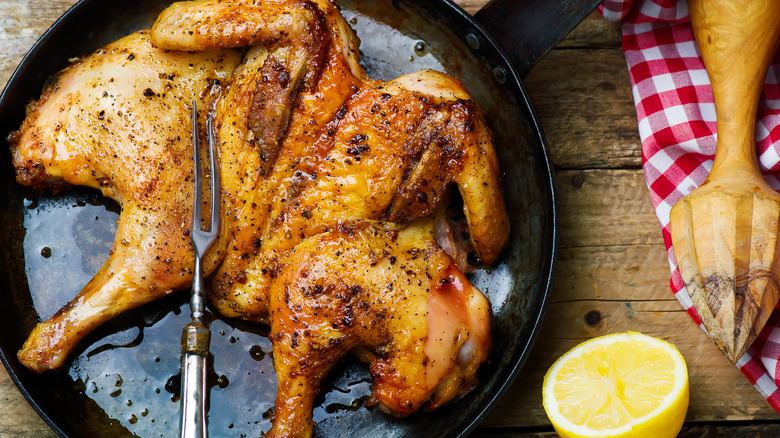Why Roasting Chicken Under A Brick Creates The Crispiest Results
Who doesn't love a good roast chicken? With its golden crispy skin and juicy, tender interior, it's no wonder that roast chicken is a popular selection for many a Sunday dinner. In fact, you may not even be able to call it a roast chicken if doesn't have its trademark crispy exterior — anything less would remind one of chewing on a flavorless, squishy, wet piece of boiled chicken. That's why, in search of getting the crispiest skin on your hunk of bird, you may need to turn to a rather unconventional tool: a brick.
Yes, you heard us right, a brick. An actual, honest-to-goodness, clay-and-stone brick. Of course, you may have more than a few questions, such as what exactly you're supposed to even do with it. Are we supposed to tenderize the chicken with a brick like some sort of caveman? Not quite! To prepare a chicken with a brick, all you need to do is simply spatchcock (or remove its backbone) a chicken and then lay a brick (wrapped in aluminum or tinfoil) on top of the chicken so that the bird is rendered as flat as can be. The chicken is then roasted at very high heat with the bricks still on top of it. This method ensures that your chicken will get a deliciously crispy and golden exterior each time.
But how exactly does laying a brick give your roast chicken a crispy skin? The answer lies within two key factors: weight and surface area.
The weight of the bricks means more surface area is exposed
While we joked earlier about the idea of you tenderizing the chicken with a brick as your mallet until it's as flat as can be, the actual reason behind what makes this method so successful isn't too far off. In fact, the more weight you have flattening your bird means more surface area will be exposed to the heat of your oven.
Think about it like this: if you put a whole chicken in the oven, only a select part of the chicken — in most cases, the bottom — is exposed to all that intense heat from the oven. The rest of the chicken, while it does cook, doesn't brown as effectively because it's not against that dry heat. By removing the backbone of the bird, you can butterfly your chicken so that more of its surface can be exposed to heat as much as possible. The bricks, while fortunately not adding any flavor to the chicken, help to ensure that the chicken stays flat, much like a weighted object keeping a book open. By weighing a butterflied chicken down, more of the chicken's skin will brown much more evenly and keep the meat juicy and tender without drying it out.
But where did the idea of flattening a chicken with a brick come from? The origins of the chicken-under-a-brick hack have roots in Italian and ancient Roman culture.
The ancient Romans used a similar method for their chicken
While the idea of cooking a chicken under a brick sounds like something dreamed up in the hectic madness of the modern world, the truth is that the idea of cooking poultry under heavy ceramics actually dates back to the times of the ancient Romans. Indeed, not only was chicken under a brick (or at least as we know it today) born from the ingenuity of the Romans, it also served as a key meal for hungry Roman soldiers.
If a Roman soldier was out on a campaign, they would usually be expected to cook and prepare their own meals. For this purpose, foods were cooked in what was known as a clibanus, a sort of plate that would be topped with a dome, which itself would be loaded down with hot coals. The heat from the coals radiated into the empty dome, which in turn would cook the food. As time went on, soldiers would use a heavy tile to weigh their fowl or poultry down instead of a dome, which would more efficiently cook the meat. This practice, while somewhat adapted to more modern times, is still used in parts of Italy, where clay cooking sets with a heavy tile can be purchased.
Although you may not be a Roman soldier yourself, you can still carry on this tradition by putting a brick or two on your chicken to ensure a crispy, evenly-cooked bird.


